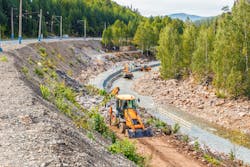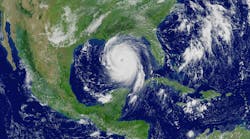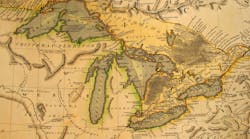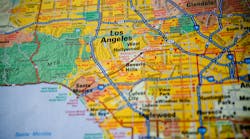Have you ever driven along an interstate and noticed a steep slope on the right-of-way (ROW) eroding away? A number of factors can cause this problem which prevents traditional slope cover like grass from being able to effectively grow and control erosion. The Georgia Department of Transportation (GDOT) faces this challenge across the state.
Determined to find a solution, the Landscape Architecture Unit at GDOT partnered with The Ray C. Anderson Foundation, a nonprofit focused on improving the safety, ecology and beauty of highways; University of Georgia College of Environment and Design Professor Brad Davis; and Auburn University Professor of horticulture Dr. Josh Weaver. This group worked to identify potential solutions that will help control erosion by utilizing innovative techniques and products to create a new standard for interstate ROW that saves taxpayer dollars, reduces maintenance needs and is more beneficial to the environment.
The result: Terraseeding.
Terraseeding® is a unique, cutting-edge process where seed and composted soil are mixed and applied to large areas using an Express Blower Truck. Similar to hydroseeding, which uses seed and water, Terraseeding® is more efficient in preventing erosion on steeper slopes. It also uses native grasses and perennial wildflowers that support the local ecology and pollinators. A win-win for GDOT.
“Terraseeding® was developed in the Pacific Northwest as a customizable solution to soil erosion that can offer better seed protection and moisture control than hydroseeding,” said Matt Quirey, landscape design and research fellow at The Ray. “What’s really cool is the Terraseeding® contractor, Cherokee Materials, uses waste from Georgia’s peanut industry – the hulls – within the soil mixture, making it a more sustainable process, too.”
GDOT and The Ray partnered on the project as part of a Landscape Lab located on Exit 14 off Interstate 85 in LaGrange, Georgia to test the feasibility and cost-effectiveness of Terraseeding® inGeorgia. It’s the latest phase of research investigating new and more sustainable approaches to the design and maintenance of highway ROW. The Landscape Lab was an idea developed by UGA’s Brad Davis, The Ray, and GDOT.
“The idea behind the Landscape Lab was to develop a research area that works with nature rather than against it by incorporating native grasses and perennials that thrive in harsher conditions such as roadside ROW,” said Davis. “We worked together to determine optimal seed mixes to use in the roadside environment and combined it with Terraseeding® to test a more sustainable stormwater management solution.”
Quirey said the location on Exit 14 was selected because of its slope conditions. “It is a steep grade and stormwater runoff caused significant erosion and rutting,” he stated. “Traditional grass was not effective erosion control and because of the grade, it posed a challenging and potentially unsafe landscape for mowers to maintain.”
Before installation could begin, the slope was bulldozed and regraded. GDOT’s District 3 office used this as an opportunity to train new employees on grading, and without them, this project would not have happened.
In the works since 2019, the research project was installed in April 2022 into two main test areas. One consists of Terraseeding® installed by Cherokee Materials. The other, managed by Dr. Josh Weaver, incorporates four areas of soil amendment testing covered with jute: the control, one with biochar, one with humic acid, and one with a combination of biochar and humic acid.
Although more costly upfront, the benefits of Terraseeding® and cost of maintenance in the long run are more favorable over hydroseeding. Grass must be mowed at least four times a year, while, once established, Terraseeding® will only need mowing once a year, saving millions in taxpayer dollars each year.
“The goal of the research in the Landscape Lab is ultimately to achieve a 'no mow slope' by determining the best seed mix, method of planting, and which soil amendments, if any, work best to establish new plants. The results will hopefully lead to a new option for contractors in Georgia to choose when finishing road projects,” said Weaver.
Construction companies currently use hydroseeding of turf grasses because they need something that grows fast to prevent improper runoff. Seeds used for Terraseeding can take a couple years to germinate and grow to their full potential. To combat improper runoff while the plants grow and mature, Terraseeding® allows the peanut-hull soil mixture to be easily spread in a three-to-four-inch layer that acts like a sponge for rainwater, absorbing it rather than allowing it to erode the slope.
The chosen seed mix won’t produce a manicured bed of flowers, but rather a habitat of native species that GDOT landscape architects refer to as the “new aesthetic.” Included are species such as Black-eyed Susan, White Prairie Clover, Lemon Mint, Gray Goldenrod, Plains Coreopsis, Wild Bergamot, Showy Evening Primrose, and Ascleipius, also called Butterfly Weed, which is a milkweed that is essential for Monarch Butterflies to reproduce. The mix and soil were pumped onto the embankment by Cherokee Materials, who parked its Express Blower Truck on the shoulder and spread the material with a hose providing a faster, more even distribution.
This research project is still in its infancy. Over the next two years, GDOT and The Ray will monitor this slope stabilization and stormwater management project to determine whether this technique has an apparent cost/benefit correlation, its long-term effectiveness, reduction in maintenance, and how the plants performed. A status update on the project will be completed by the end of 2022. The project’s final report is expected to be released in 2024.






